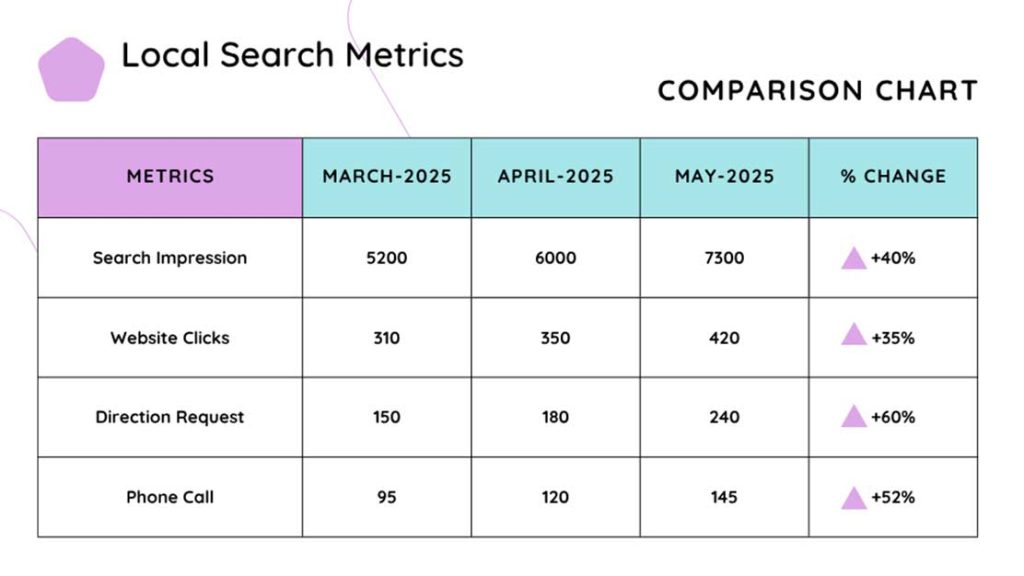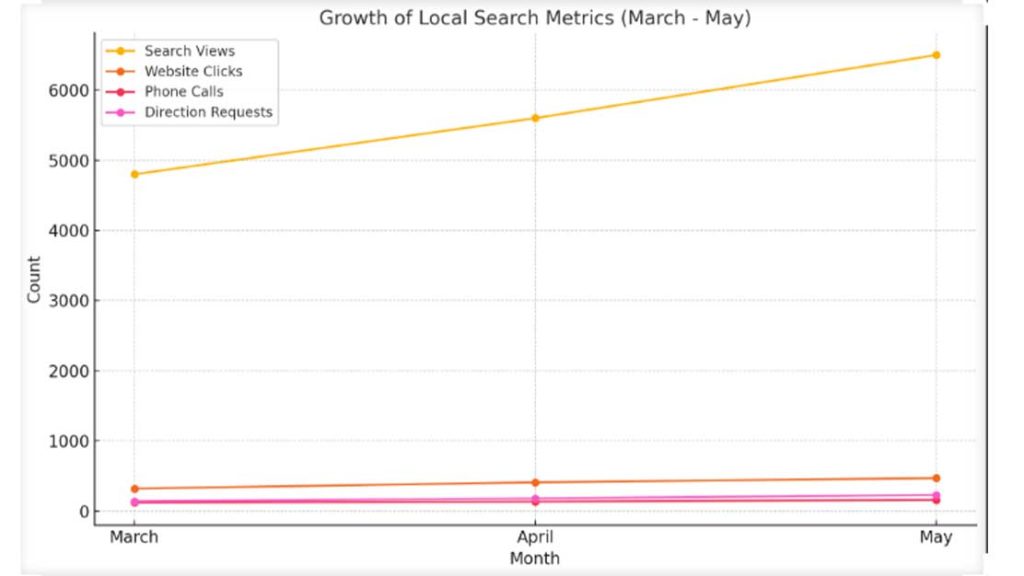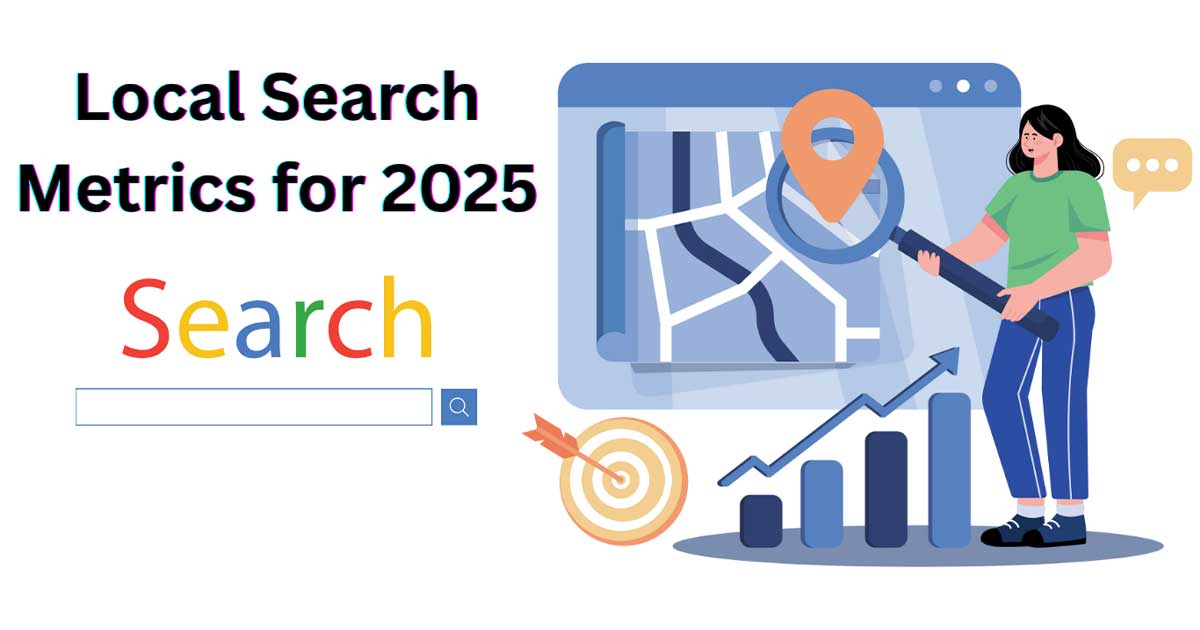Are you paying attention to your Local Search Metrics?
In today’s world, when someone needs a nearby shop, restaurant, or service, they usually search online first. That’s where Local Search Metrics come in. These are the numbers that show how often people are seeing your business in local search metrics—like how many clicks you get, how many people ask for directions, or how many times your profile pops up on Google.
In this blog, we’ll break down what Local Search Metrics are, why they matter, and how understanding them can help your business grow in your local area.
We’ve put together a list of 15 standout Key Performance Indicators that could flip the script on how you measure success. Items such as Google Business Profile click and hyperlocal sales ratios will give your strategy a sharp, fresh edge.
Whether you run a corner pizza shop or handle marketing projects on a corporate level, this guide is built for you.
Here is what you will get:
- Clear, number-based ideas to leave nearby rivals in the dust
- Up-to-the-minute tracking tips that make sure you never go unseen
- Practical moves to rally locals and keep them coming back
- Brand-new metrics that show how search traffic actually turns into dollars
Key Takeaway
Google Business Profile activity and targeted on-page tweaks are set to steal the spotlight, and with nearly half of all searches carrying a local tag, the case for attention is rock-solid.
How do your Local Search Metrics really look?
Take a second and think about whether your shop pops up when folks nearby type a quick search into Google. That real-time glance is exactly what Local Search Metrics track.
Local Search Metrics boil down all the online chatter into bite-sized numbers. They count how many eyes land on your listing, how often someone clicks your link, and even how frequently a caller’s voice rings inside your store.
Scan those figures in a neat chart, and any blind spots jump out at you. Seeing what already shines and what still needs polish makes it far easier to lure in more neighbors who didn’t even know you were around.

Are your Local Search Metrics showing real progress?
Ever wonder whether anyone around your town is spotting your company on the web? That curious little question is exactly why people lean on Local Search Metrics.
These handy figures keep an eye on who checks your Google listing, who hops over to your site, who dials your phone, and even who requests directions. A quick peek at the stats shows whether you’re really clicking with folks down the street.
The chart at the top traces the march of each metric from March through May. Those rising curves whisper where to double down and where your current moves are already winning local hearts.


15 Local Search Metrics for 2025: KPIs That Spike Sales
A Quick Win for Neighborhood Businesses
Things move fast online, and companies that want to win can’t sit still. Local search metrics has been quietly leveling up for 2025, and businesses that notice early will pull ahead. Getting a handle on local KPIs now is job one for anyone planning to stick around.
Check out these 15 everyday metrics; they could reshape how your store, surgery, or service gets found next year.
Metrics That Matter
Grab a notepad. The following 15 local search metrics could flip your sales script upside-down.
Local Search Visibility
It’s one thing to own a storefront and another to own the first page of search results. Visibility tracking tools let you peek behind the curtain and see exactly where you’re landing.
GMB Insights
Google My Business is still the must-have sidekick for local shops. Pop opens the Insights tab and watch the search queries, views, and clicks roll in.
Customer Reviews and Ratings
One five-star review can outweigh a half-dozen boring ads. Keep tabs on feedback and be quick to thank or calm customers on Google, Yelp, and niche sites that matter to your audience.
Online Directories Accuracy
A different phone number or a missing suite number can send a hungry customer to the wrong door. Double-check that your info matches up across every directory, from Yelp to Yellow Pages.
Click-through Rate (CTR) from Local Search Metrics
When a business posts wrong phone numbers or faulty store hours, customers get lost-and search engines notice. Messy data like that can really sink a sites ranking in local results.
Mobile Search Performance:
How often do people click your link after seeing it in a search? A quick look at the click-through rate tells the story. If the number is flat, the page titles or meta tags probably need a fresh rewrite.
Smartphones rule, so keep an eye on how fast your site opens on a small screen. Pages that lag risk losing local visitors who just want directions.
Voice Search Compatibility: Local Search Metrics
Voice searches, spoken out loud instead of typed, keep rising in popularity. To catch those queries, writers must lean into casual wording and answer common questions directly.
Local Keyword Rankings: Local Search Metrics
Do a pulse check on where your domain lands for key local phrases. Ranking reports show which keywords are moving up and which ones are drifting, giving marketers a chance to pivot.
Social Media Engagement: Local Search Metrics
Links from neighborhood blogs or chamber websites count for extra credit. A portfolio filled with trusted local domains can lift a site’s authority and visibility in geographic queries.
Localized Content Creation
Profiles on Facebook, Instagram, and Twitter don’t just sit there. Posts that rack up likes, shares, and comments nudge algorithms to show the brand to more people nearby.
Local Content Performance
Take a close look at blog posts or landing pages written just for your neighborhood. Checking how many people read, share, or bookmark this content tells you if it still feels fresh and local.
Local Pack Clicks
Keep an eye on the tiny set of map pins and business names that pop up above regular search results. More clicks from that box mean your profile is catching eyeballs when it counts.
Local Conversion Rate
Work out how many of those nearby visitors actually buy something or fill out a contact form. That simple percentage shows whether chasing local traffic is paying real cash dividends.
Geo-Targeted Ads
If you’re running pay-per-click ads that point only to zip codes you serve, watch the cost-per-click and return on ad spend numbers like a hawk. A small drop in CPC paired with a jump in ROAS turns a good month into a great one.
Competitor Snapshots
Check what the shops down the block are doing with their Google listings, reviews, and neighborhood deals. Copy nothing outright but steal the spirit of any tactic that seems to be working like magic.
Solid Strategy
Leaning on these 15 clear local search metrics in 2025 gives you an edge the competition won’t see coming. Blend the data with genuine, friendly customer service, and your business will stay top-of-mind when times get rocky.
Customer Engagement and Interaction Metrics
Website Traffic Analysis
If you run a neighborhood shop or a service that relies on the web, knowing how people drift through your site is half the battle. When you trace their clicks, scrolls, and pauses, the raw numbers turn into a map of what grabs attention and what yawns away.
One number you can’t ignore is the bounce rate. A high bounce figure is like a customer walking in, glancing around, then leaving before you can say hello, so your first page probably needs fresh paint-and maybe a sharper headline.
You should also peek at the click-through rate between pages because it tells you where people decide to stick around. One grocery-store recipe post may skyrocket while a dry product explanation sinks; either way, the gap shows where good ideas are hiding and where fresh thinking is overdue.
Conversion Tracking
Tracking conversions is the scoreboard that finally turns curiosity into cash, and for local pros, the score matters a lot. When more visitors end up calling, buying, or signing, the town-sized buzz around your work is officially backed by proof.
To stack the deck, put clear goals into your favorite analytics tool: counting form fills, phone-tap clicks, quick map nudges, newsletter shouts, and, yes, the checkout chime. Each ding that registers reveals which corners of your online presence nudge folks from Im thinking about it to I want that right now.
Spend some time tightening up the pages that already draw a crowd but don’t end up cashing in. A few smart tweaks here can lift the whole site’s bottom line.
Dump the raw numbers into fresh buckets by where the clicks came from, what kind of phone or laptop folks are using, and which city they logged in from. The little patterns that pop out will steer your local ads so they hit closer to home.
Online Reputation Metrics-Review Management
Keeping an eye on customer reviews is like polishing the shine on your shop window. When new visitors see fresh praise, they’re more likely to walk inside.
A simple dashboard lets you track the plus signs: average star rating, review volume, and how fast you reply. Even one missing number can leave a dent in your image.
Perfect five-stars feel staged, so many buyers lean toward ratings that settle around 4.2 to 4.5. That small dip makes a big difference in trust.
Feedback flow tells its own story. Day after day of new stars means people are happy enough to take five seconds and post.
Ignore the bad notes at your peril; they’re the map to the cracks in your service. Answering them in public signals that you care, even when the message hurts.
The stopwatch on your replies matters, too. Fast action shows the world that every customer, cranky or cheerful, is worth your minute.
Try to answer both happy shout-outs and angry rants within a day or two. When you do that, everyone- especially newcomers-sees that you actually care. Research shows that 45% of shoppers will check out a store that fights back against bad reviews. Crazy, right?
Keep a Close Eye on These Five Must-Watch Numbers:
the monthly flow of fresh reviews, whether the mood is sunny or stormy, how each web Google, Yelp, your niche spot-charts out, the word count customers drop, and how fast those voices keep coming.
Step back every so often and look at the bigger picture. If you suddenly get a flood of one-star complaints, something’s broken and needs fixing yesterday. On the flip side, steady praise about your tacos or tech tells you exactly where to keep shining.
Customer value and retention metrics never go out of style. They tell you if people are sticking around and how much more they might spend if you treat them right.
Digging into customer lifetime value is like shining a flashlight into the future. It helps you decide how much cash is smart to spend chasing new faces while keeping your loyal crowd happy.

Customer Lifetime Value
Customer lifetime value (CLV) sums up how much a single shopper is worth to your company from the first buy all the way to the last. The number pulls in the average order size, how often they repurchase, and a few other important stats. Put those pieces together and you get a clearer picture of long-term worth, not just a one-off sale.
Start the CLV calculation by figuring out your average order value for different buyer groups. New shoppers might place quick, small tickets, but many loop back later and RAISE the dollar amount once they trust the brand. Spotting those trends shows you which segments really drive dollars.
The yearly repurchase rate links tightly to the lifetime value story. By logging how often a customer reappears to checkout again, forecasting future cash flow becomes easier and marketing plans fall neatly into place. More trips equal more dollars and that basic rule holds firm across most industries.
A second, handy predictor of loyalty is the net promoter score, or NPS. It gauges how likely current customers are to tell friends about your service or product. Higher NPS numbers usually shout, Im happy here; lower ones signal trouble ahead and can steer you toward fixes.
One quick way to keep shoppers around is to watch their buying habits like a hawk.
- Check how often they log in or stack new carts.
- Pay attention to surveys and quick feedback loops.
- Spot the folks who go silent and reach out early. Targeted perks like discounts, extra points, or early access often tip the scales in your favor. Even after launching a loyalty program, keep running the math to see if those efforts actually pay off.
In Conclusion
Hey, do you regularly check your Local Search Metrics?
Local Search Metrics are vital to your success if you wish to attract more local buyers to your website. By knowing these figures, you can easily tell which methods successful and which ones are are not, and you can also find out what you can do to achieve better results.
Concentrating on the most critical Local Search Metrics will enable you to take action that will increase the number of local customers, increase the visibility of your business on the Internet, and thus make your company more robust in the area you are at.
FAQs-Local Search Metrics
What exactly are local search metrics?
Local search metrics tell you how many people saw your listing, clicked it, and asked for directions.
Why bother keeping an eye on these numbers?
You can see how customers find you and adapt your local SEO strategy accordingly.
Where do I dig up my local stats on Google?
The Insights tab in Google Business Profile shows how many users found you using search or maps.
How often should I peek at my local search metrics?
Check once a month to spot trends and adjust your strategy as necessary without getting anxious about it.
Which Tools Track Local Search Metrics?
Google Business Profile Insights is one tool that provides basic information. While Bright Local and Moz Local go deeper in uncovering trends easily.

